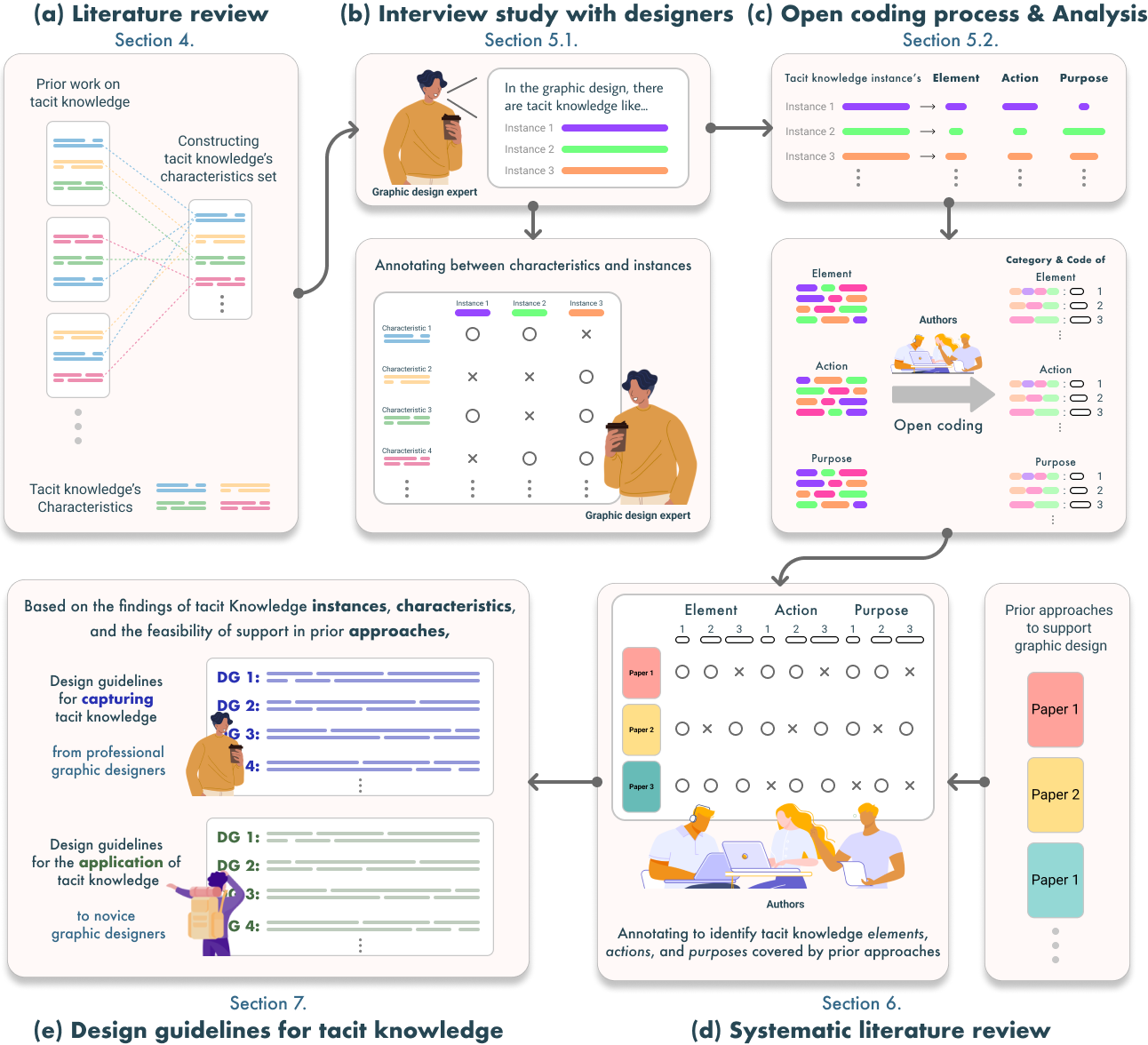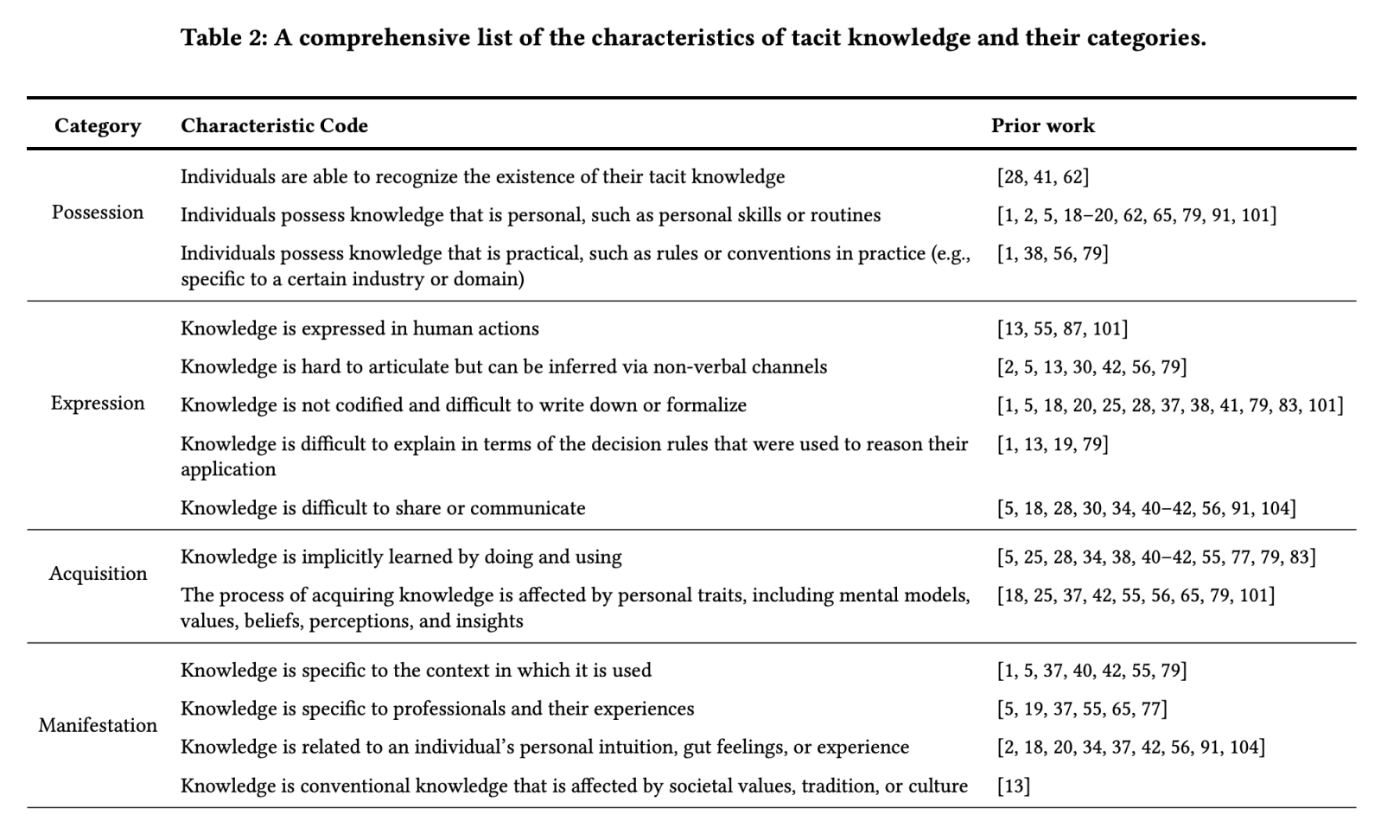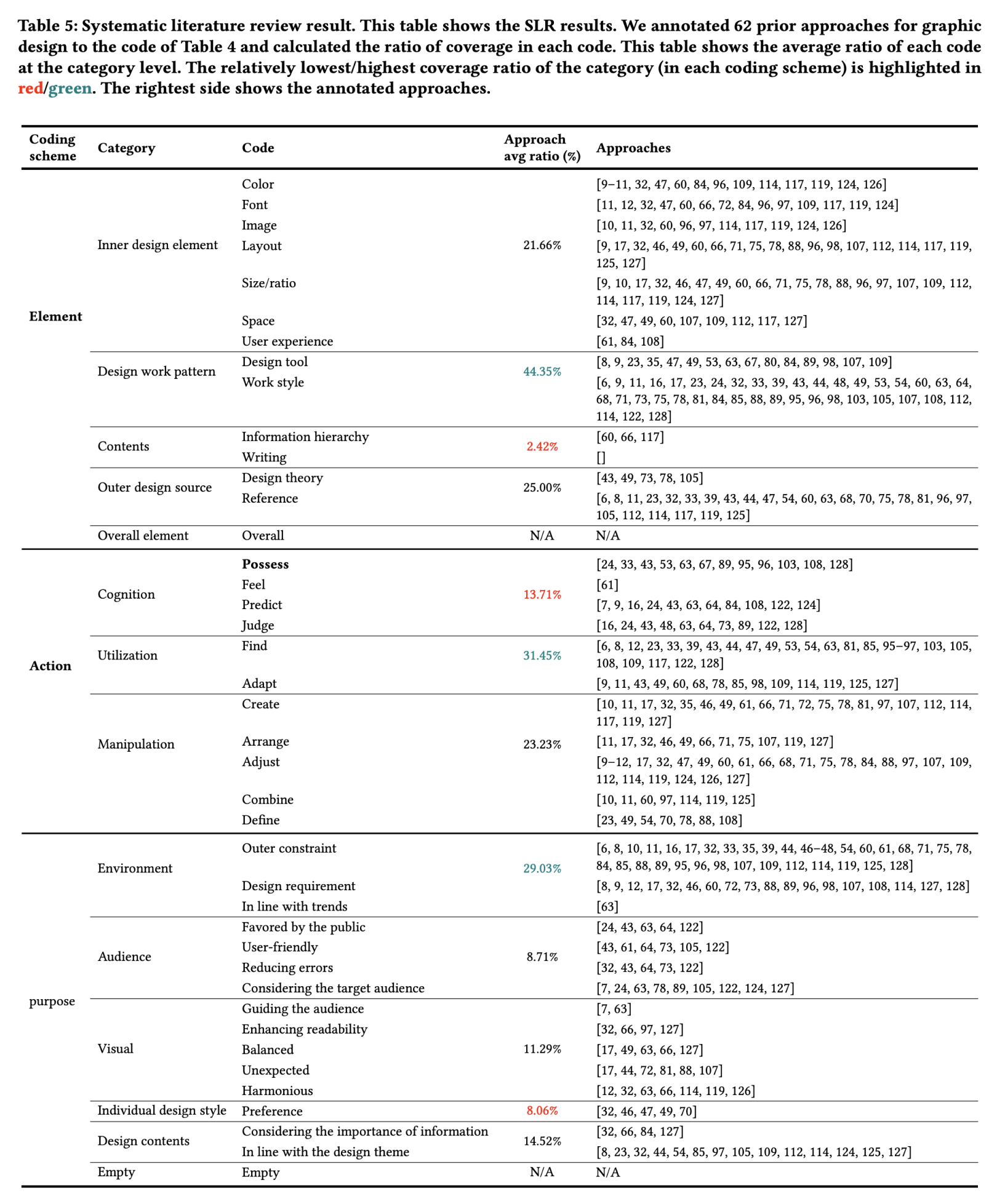Abstract
Despite the growing demand for professional graphic design knowledge, the tacit nature of design inhibits knowledge sharing. However, there is a limited understanding on the characteristics and instances of tacit knowledge in graphic design. In this work, we build a comprehensive set of tacit knowledge characteristics through a literature review. Through interviews with 10 professional graphic designers, we collected 123 tacit knowledge instances and labeled their characteristics. By qualitatively coding the instances, we identified the prominent elements, actions, and purposes of tacit knowledge. To identify which instances have been addressed the least, we conducted a systematic literature review of prior system support to graphic design. By understanding the reasons for the lack of support on these instances based on their characteristics, we propose design guidelines for capturing and applying tacit knowledge in design tools. This work takes a step towards understanding tacit knowledge, and how this knowledge can be communicated.

The diagram shows the overall research procedures with arrows. First, (a) is a literature review process for collecting tacit knowledge characteristics. (b) shows that the authors did an interview study with graphic design experts to collect the tacit knowledge instances. In the study, the designers also conducted an annotation task between the instances they mentioned and the characteristics set. (c) is the open coding process to analyze the instance of the collected tacit knowledge. Then, the authors conducted a systematic literature review to investigate what type of instance is still uncovered at (d). Based on these series of research steps, this paper suggests the design guidelines for capturing and applying tacit knowledge at (e).
Our study aims to investigate tacit knowledge in graphic design deeply by identifying the characteristics and instances of tacit knowledge, as well as by reviewing prior approaches for supporting the usage of design knowledge. The ultimate goal is to propose design guidelines for systems that support the capture and application of tacit knowledge. Based on these research goals, we defined three research questions:
The below table shows the terms and their definitions used in this paper.

According to Leonard and Sensiper (1998), knowledge exists on a spectrum from tacit and unconscious knowledge to explicit and codified knowledge. The majority of knowledge falls somewhere in this knowledge spectrum. This can be interpreted as having varying degrees of tacitness (Lee et al., 1983; Jeremy, 1996) depending on how difficult it is to share and communicate. Hence, identifying the characteristics of each tacit knowledge has to be the first step to understanding it deeply.
While prior work has described some of the characteristics, to the best of our knowledge, no study has provided a comprehensive list with the described characteristics from prior work. In this background, we first assembled and organized the characteristics defined in prior work through a literature survey.

To identify concrete instances of tacit knowledge in the graphic design domain and understand what characteristics these instances possess, we conducted an interview study with 10 graphic design experts. Through the study, we collected 123 instances of tacit knowledge. Then, we analyzed how tacit knowledge is manifested in graphic design by performing a qualitative coding of the collected instances according to the element where the tacit knowledge is revealed, the action taken by the knowledge subject to use the tacit knowledge, and the purpose of using that knowledge.

To investigate gaps between the investigated instances and the prior approaches that support the graphic design process (e.g., design creation, knowledge sharing, etc.), we conducted a systematic literature review (SLR) on approaches, encompassing systems, techniques, and methodologies related to graphic design. By annotating the elements, actions, and purposes of instances supported explicitly by the approach, we investigate how existing approaches address different types of tacit knowledge in graphic design. This SLR aims to uncover what categories or codes of tacit knowledge instances remain unsupported or under-supported and to analyze the reasons through the characteristics of tacit knowledge.

we propose two sets of design guidelines: 1. to capture tacit knowledge from experienced designers, and 2. to support those that lack the knowledge in applying it in their own design processes. Specifically, we aim to provide guidelines aligned with contemporary graphic design practices, predominantly conducted on web and app-based design tools or systems.
The guidelines are designed based on the main findings of the study.

This work investigates the tacit knowledge in graphic design by identifying the instances, characteristics, and prior approaches. Through the interview and annotation study with professional graphic designers, this study proposes specific elements, actions, and purposes of tacit knowledge instances in graphic design with their characteristics. Also, systematic literature review and annotation process reveal the less covered elements, actions, and purposes of tacit knowledge by prior approaches that support the graphic design process. Finally, this study proposes design guidelines to capture and support the application of tacit knowledge, considering the characteristics of the instances in graphic design. Our work contributes to the future where tacit knowledge could be actively shared by demystifying tacit knowledge in graphic design.
@inproceedings{son2024demystifying,
title={Demystifying Tacit Knowledge in Graphic Design: Characteristics, Instances, Approaches, and Guidelines},
author={Kihoon Son and DaEun Choi and Tae Soo Kim and Juho Kim},
year={2024},
eprint={2403.06252},
archivePrefix={arXiv},
primaryClass={cs.HC}
}
This work was supported by Institute of Information & Communications Technology Planning & Evaluation (IITP) grant funded by the Korea government (MSIT) (No.2021-0-01347, Video Interaction Technologies Using Object-Oriented Video Modeling and No.2019-0-00075, Artificial Intelligence Graduate School Program(KAIST)).